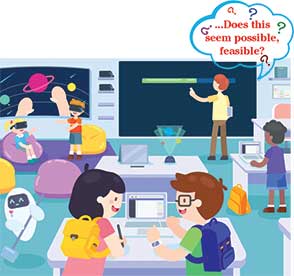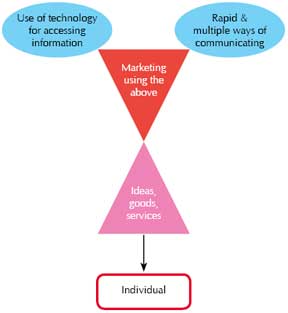G. Gautama
In building enormous institutions and employing teachers who depend on a system instead of being alert and observant in their relationship with the individual student, we merely encourage the accumulation of facts, the development of capacity, and the habit of thinking mechanically, according to a pattern; but certainly none of this helps the student to grow into an integrated human being. Systems may have a limited use in the hands of alert and thoughtful educators, but they do not make for intelligence. – J. Krishnamurti, Education and significance of life Chapter 5
One of the observable factors over the past 30-40 years is the emergence of new technologies and alternative ways of doing many things. The number of things that people can do differently has increased and with it a greater complexity has crept into all aspects of human life – relationship, work, leisure, entertainment. Pressure on large systems, such as education, would have to be addressed and met with depth and clarity to retain direction and informed focus.

It is well known that with every added degree of complexity the system has to adjust and re-configure itself. When multiple factors creep in, the number of adjustments needed increases. One needs to move to rethinking the matrix at some stage in the change process. This may require re-articulation of purpose, examination of alternate forms and structures. Most exciting and difficult will be decisions regarding which forms and structures to preserve, which to modify and which to let go. It is understood that disruption precedes the emergence of a new order, a new equilibrium. Certainly not work for the faint hearted…
Unfortunately most schools do not seem to have done much work of assimilation of the new processes into their core intentions but merely allowed entry to these processes assuming, rather naively or helplessly, that they are merely another way of doing things.
All process and intentions are buried in form. One may ask what elements of form will help address the above set of influences. There are few elements that govern the morphology of a school – class size, arrangement, expectations, tools used, guides channeling socialization, etc.
Current disruptions in the schooling arena are as follows:
- Use of technology for accessing information: unrestricted access to wide range of material – text, images and video.
- Rapid and multiple ways of communicating among peers and stakeholders – text, voice, social media, mail and video conference, multiple users joining simultaneously.
- Marketing – selling of an idea and goods in sophisticated ways using the above.
Each of the above factors comes with its own imperatives and schools need to see this clearly. Most schools are leaning on the technological conveniences and have accepted the inevitability of their use even, often without any debate. The form of school, the classroom and the pedagogy has largely remained untouched and now allow for important redefinition for the 21st Century.
Use of technology for accessing information leads to unrestricted access to wide range of material – text, images and video. The visual becomes important, more important than reading and listening. Instant information is available and its presentation influences our thinking and feelings.
Information when not checked for fact may range from highly educative perceptions to completely meaningless and false constructions.
One who accesses information would need to be educated to read carefully, between the lines and also enquire, if the views expressed are valid. Danger to children from sources hitherto unknown (stalking, grooming, pornography, violence, fundamentalism, etc.) need a response. One needs to have enough physical activity and use of other senses, one needs to learn the art of listening.

Rapid and multiple ways of communicating among peers and stakeholders – text, voice, social media, mail and video conference, multiple users joining simultaneously.
More communication does not necessarily become better. Multiple approaches need one to learn to use multiple platforms and this keeps one engaged. Sending and receiving messages becomes more important than engaging with this information sensibly.
One unwittingly enters a world where smart and witty answers, impolite and abusive expression become the accepted norm. There is heightened anxiety about how one is being perceived or received. Learning the art of listening and responding intelligently has become critical.
Marketing – selling of an idea and goods in increasingly sophisticated ways using the above is widespread. The line between informing and persuading has always been thin. Now it is blurred. This is pernicious and converges on young minds with great subtlety and force.
Staying firm on the ground of questions is one way to counter this. Understanding one’s feelings and their origins and learning to question one’s drives and motivations without feeling invalidated and defeated is a way to understand one’s conditioning and susceptibilities. A grounding in personal discipline – yoga, exercise, tai chi … regular exercise for oneself, one’s body and mind is important.
Without such a shift in direction, the changes in the environment will have finessed the intentions of the school system and instead of education, convert them into their agenda. The nameless forces unleashed with these systems and their messaging is much more powerful than that of the school processes.
Form and content changes are possible as follows:
- Accent on learning, not on teaching, would shift the classroom / work process to engagement. Gathering of individuals (classroom) becomes a way to tap into diversity.
• Study and meeting spaces would need people to engage with each other.
• Class would not start with lecture but in other ways. - Shift from competition to collaboration where peers are not to be bettered but to learn from and learn with and considered as valuable resources.
• Discussing various perspectives is an approach to the next step.
• Differences are seen as valuable contributions. - Shift from single right answer / single point of view to multiple answers / many points of view.
• Exam process to shift from demonstrating knowledge to give evidence of ability to learn, to offer multiple explanations.
• What is the right answer changes to What are 3 possible approaches to a question?
• One would need to learn to argue for and against.

If numbers matter, people don’t… if the measurable matters, that which can’t be measured matters less. There are more corollaries.
- If age matters, a student’s state of mind doesn’t as students will be put in age appropriate slots –
• Is Mixed Age Grouping (MAG) a way of valuing each student, irrespective of age? - If marks matter, student’s goodness, kindness, generosity counts less or not at all –
• How do we include that which can’t be measured in our perception of the student? Reports, invitations and conversations. - If speed matters, then slower students will not count –
• How do we value individuals who are accomplished and those who are not, simultaneously, and in the same environment?
- If money and property matter, then those things that money can’t buy matter little or not at all. If building, infrastructure and facilities matter, people matter less or only as numbers.
• How do we value the process of our interactions and learning that are free of the weight of the infrastructure?
• How do we value what can’t be purchased?
Unfortunately the entire focus of the education system is on content and certification but not on what goes on daily in a classroom and the exam process. With the large scale orchestration that has become the order of the day, funnelling diversity into narrowing channels of specialization, education does not seem to edify each and every student.
If some of the above changes can be implemented carefully, the invigoration of the education system will follow. It is hoped that with the suggested shifts, these primary imperatives will be restored. After all education has existed for centuries and has multiple approaches honed by millennia. It would be a pity if it is reduced to screens, personal and shared and worshipping at the altar of operating systems.
The author has worked in KFI schools for 32 years, 18 as principal of The School, KFI and has been involved in setting up the newest of KFI schools, Pathashaala, from its inception. His central concerns have been the growth of teachers and enabling a vibrant culture of working together in the light of the teachings of Krishnamurti. He can be reached at gautama2006@gmail.com.
